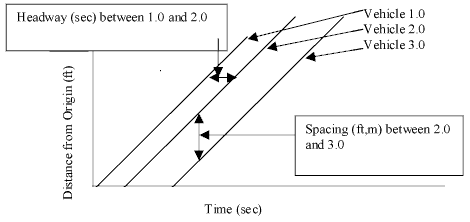
Time-Space Diagrams
A time–space diagram is commonly used to solve a number of transportation- related
problems. Typically, time is drawn on the horizontal axis and distance from a reference
point on the vertical axis. The trajectories of individual vehicles in motion are
portrayed in this diagram by sloping lines, and stationary vehicles are represented by
horizontal lines. The slope of the line represents the speed of the vehicle. Curved
portions of the trajectories represent vehicles undergoing speed changes such as
deceleration.
Diagrams that show the position of individual vehicles in time and in space are very
useful for understanding traffic flow. These diagrams are especially useful for
discussions of shock waves and wave propagation.
The time-space diagram is a graph that describes the relationship between the location
of vehicles in a traffic stream and the time as the vehicles progress along the highway.
The following diagram is an example of a time-space diagram.

Time-space diagrams are created by plotting the position of each vehicle, given as a
distance from a reference point, against time. The first vehicle will probably start at
the origin, while the vehicles that follow won’t reach the reference point until
slightly later times. Reductions in speed cause the slopes of the lines to flatten, while
increases in speed cause the slopes to become greater. Acceleration causes the time-space
curve for the accelerating vehicle to bend until the new speed is attained. Curves that
cross indicate that the vehicles both shared the same position at the same time. Unless
passing is permitted, crossed curves indicate collisions.
|